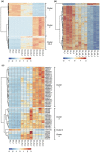The commitment of barley microspores into embryogenesis correlates with miRNA-directed regulation of members of the SPL, GRF and HD-ZIPIII transcription factor families
- PMID: 36406053
- PMCID: PMC9671080
- DOI: 10.1002/pld3.289
The commitment of barley microspores into embryogenesis correlates with miRNA-directed regulation of members of the SPL, GRF and HD-ZIPIII transcription factor families
Abstract
Microspore embryogenesis is a model for developmental plasticity and cell fate decisions. To investigate the role of miRNAs in this development, we sequenced sRNAs and the degradome of barley microspores collected prior to (day 0) and after (days 2 and 5) the application of a stress treatment known to induce embryogenesis. Microspores isolated at these timepoints were uniform in both appearance and in their complements of sRNAs. We detected 68 miRNAs in microspores. The abundance of 51 of these miRNAs differed significantly during microspore development. One group of miRNAs was induced when the stress treatment was applied, prior to being repressed when microspores transitioned to embryogenesis. Another group of miRNAs were up-regulated in day-2 microspores and their abundance remained stable or increased in day-5 microspores, a timepoint at which the first clear indications of the transition toward embryogenesis were visible. Collectively, these miRNAs might play a role in the modulation of the stress response, the repression of gametic development, and/or the gain of embryogenic potential. A degradome analysis allowed us to validate the role of miRNAs in regulating 41 specific transcripts. We showed that the transition of microspores toward the embryogenesis pathway involves miRNA-directed regulation of members of the ARF, SPL, GRF, and HD-ZIPIII transcription factor families. We noted that 41.5% of these targets were shared between day-2 and day-5 microspores while 26.8% were unique to day-5 microspores. The former set may act to disrupt transcripts involved in pollen development while the latter set may drive the commitment to embryogenesis.
Keywords: Hordeum vulgare; degradome; gametic embryogenesis; hc‐siRNA; miRNA; phasiRNA.
© 2020 The Authors. Plant Direct published by American Society of Plant Biologists, Society for Experimental Biology and John Wiley & Sons Ltd.
Conflict of interest statement
The authors declare no conflict of interest associated with the work described in this manuscript.
Figures




Similar articles
-
NO, ROS, and cell death associated with caspase-like activity increase in stress-induced microspore embryogenesis of barley.J Exp Bot. 2012 Mar;63(5):2007-24. doi: 10.1093/jxb/err400. Epub 2011 Dec 23. J Exp Bot. 2012. PMID: 22197894 Free PMC article.
-
Differential Expression Profiling of Microspores During the Early Stages of Isolated Microspore Culture Using the Responsive Barley Cultivar Gobernadora.G3 (Bethesda). 2018 May 4;8(5):1603-1614. doi: 10.1534/g3.118.200208. G3 (Bethesda). 2018. PMID: 29531122 Free PMC article.
-
HvPG1 and ECA1: two genes activated transcriptionally in the transition of barley microspores from the gametophytic to the embryogenic pathway.Plant Cell Rep. 2009 Apr;28(4):551-9. doi: 10.1007/s00299-008-0662-2. Epub 2008 Dec 27. Plant Cell Rep. 2009. PMID: 19112566
-
How microspores transform into haploid embryos: changes associated with embryogenesis induction and microspore-derived embryogenesis.Physiol Plant. 2008 Sep;134(1):1-12. doi: 10.1111/j.1399-3054.2008.01113.x. Epub 2008 Apr 11. Physiol Plant. 2008. PMID: 18507790 Review.
-
Microspore embryogenesis in Brassica: calcium signaling, epigenetic modification, and programmed cell death.Planta. 2018 Dec;248(6):1339-1350. doi: 10.1007/s00425-018-2996-5. Epub 2018 Aug 31. Planta. 2018. PMID: 30171331 Review.
Cited by
-
Comparative proteomic analysis provides new insights into regulation of microspore embryogenesis induction in winter triticale (× Triticosecale Wittm.) after 5-azacytidine treatment.Sci Rep. 2021 Nov 15;11(1):22215. doi: 10.1038/s41598-021-01671-y. Sci Rep. 2021. PMID: 34782682 Free PMC article.
-
Understanding In Vitro Tissue Culture-Induced Variation Phenomenon in Microspore System.Int J Mol Sci. 2021 Jul 14;22(14):7546. doi: 10.3390/ijms22147546. Int J Mol Sci. 2021. PMID: 34299165 Free PMC article. Review.
-
Global DNA Methylation and mRNA-miRNA Variations Activated by Heat Shock Boost Early Microspore Embryogenesis in Cabbage (Brassica oleracea).Int J Mol Sci. 2022 May 5;23(9):5147. doi: 10.3390/ijms23095147. Int J Mol Sci. 2022. PMID: 35563550 Free PMC article.
-
Androgenesis-Based Doubled Haploidy: Past, Present, and Future Perspectives.Front Plant Sci. 2022 Jan 7;12:751230. doi: 10.3389/fpls.2021.751230. eCollection 2021. Front Plant Sci. 2022. PMID: 35069615 Free PMC article. Review.
-
Differential Expression Profiling Reveals Stress-Induced Cell Fate Divergence in Soybean Microspores.Plants (Basel). 2020 Nov 7;9(11):1510. doi: 10.3390/plants9111510. Plants (Basel). 2020. PMID: 33171842 Free PMC article.
References
-
- Berenguer, E. , Bárány, I. , Solís, M. T. , Pérez‐Pérez, Y. , Risueño, M. C. , & Testillano, P. S. (2017). Inhibition of histone H3K9 methylation by BIX‐01294 promotes stress‐induced microspore totipotency and enhances embryogenesis initiation. Frontiers in Plant Science, 8, 1161. 10.3389/fpls.2017.01161 - DOI - PMC - PubMed

